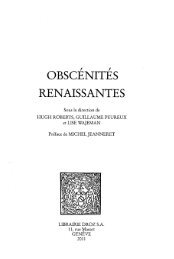Download (3398Kb) - ePrints Soton - University of Southampton
Download (3398Kb) - ePrints Soton - University of Southampton
Download (3398Kb) - ePrints Soton - University of Southampton
Create successful ePaper yourself
Turn your PDF publications into a flip-book with our unique Google optimized e-Paper software.
Larval dispersal from eight populations <strong>of</strong> the ophiuroid Ophiothrix fragilis<br />
(Abildgaard) in the English Channel was examined by Lefebvre et al. (2003) using an<br />
advection/diffusion model. Although larval dispersal and settlement <strong>of</strong> this species are<br />
apparently hydrodynamic constrained in almost all populations larval retention<br />
appeared to be sufficient to ensure local recruitment, in spite <strong>of</strong> short larval life span<br />
and/or meteorological conditions.<br />
Nowadays it is recognized that the deep sea is not a single, continuous habitat,<br />
but rather a mixture <strong>of</strong> habitats in which many species have particular specialized<br />
requirements depending on where they are situated (Tyler, 1995).<br />
The dynamic, insular and <strong>of</strong>ten temporary habitats represented by<br />
hydrothermal vents and cold seeps with a rich supply <strong>of</strong> self-produced<br />
(autochthonous) food contrast markedly with, stable, nutrient-poor and extensive<br />
abyssal plains, where all energy has its sources from the sea surface. In a similar way,<br />
the continental slope and rise include many different habitats, each characterized by<br />
specific topographic features, physical characteristics, and food interactions, and each<br />
occupied by distinct groups <strong>of</strong> species adapted to those different conditions.<br />
Therefore, reproductive modes and life-history traits <strong>of</strong> animals show a rich variety <strong>of</strong><br />
strategies for responding to the diversity <strong>of</strong> habitats in the deep sea (Young, 2003).<br />
5.3- Larval physiological tolerances <strong>of</strong> shallow-water asteroids<br />
Eggs <strong>of</strong> the shallow-water asteroids Asterias rubens Linnaeus and<br />
Marthasterias glacialis (Linnaeus) were fertilized in vitro and incubated through the<br />
early embryonic cleavages until the larval stage. Early embryos, blastulae, gastrulae,<br />
and swimming bipinnaria were subjected to a temperature/pressure regime <strong>of</strong> 5, 10,<br />
15 and 20 o C and 1, 50, 100, 150 and 200 atm.<br />
97
















